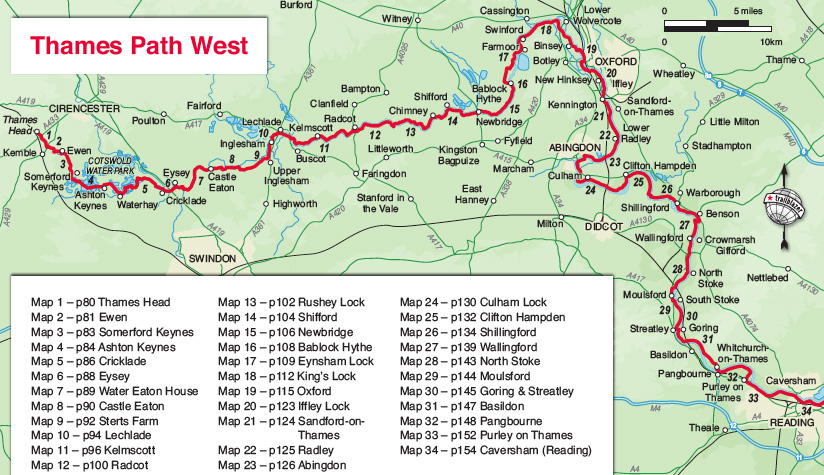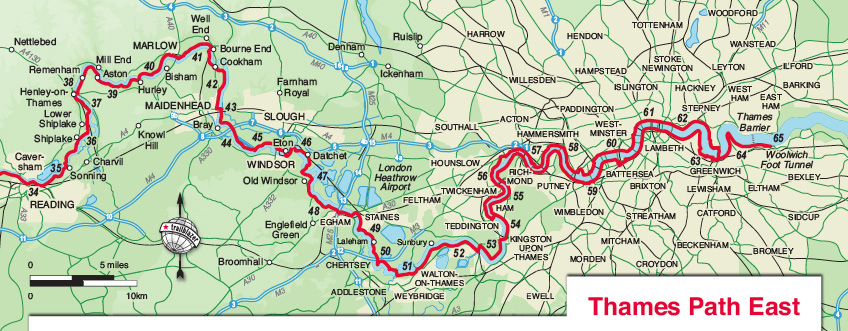
The Thames Path is one of England’s most celebrated long-distance walking trails, following the course of the River Thames from its source in Gloucestershire to the heart of London and beyond to the river’s mouth. Spanning approximately 184 miles (294 km), it provides an unparalleled opportunity to explore the scenic countryside, historic towns, and the vibrant capital while tracing the route of England’s most famous river.
The History of the Thames Path
The Thames Path has its origins in the centuries-old relationship between the river and the people who have lived along its banks. The Thames has played a pivotal role in Britain’s history, serving as a major trade route, a source of water, and a centre of cultural and political life. Over time, various footpaths and towpaths developed along its length, used by merchants, anglers, and boatmen.
The idea of a continuous footpath along the river was first proposed in 1948. However, it was not until 1996 that The Thames Path officially opened as a National Trail, after years of negotiations and careful planning to ensure safe and accessible routes for walkers. Since then, it has become a favourite among hikers, history enthusiasts, and nature lovers.
The Route: From Source to Sea
The Thames Path is typically walked from west to east, beginning at the river’s source in the Cotswolds and concluding at the Thames Barrier in Woolwich, though some extend their journey towards the North Sea.


1. The Source to Oxford
The journey begins near Kemble in Gloucestershire, where the Thames starts as a modest trickle in a rural field. In this early stretch, the path meanders through serene countryside, passing through picturesque villages such as Cricklade and Lechlade. Walkers can enjoy tranquil wetlands and lush meadows, rich in birdlife, particularly at the Cotswold Water Park.
As the river gains volume, the path leads to Oxford, the world-renowned university city. Oxford boasts an extraordinary wealth of historic architecture, from the spires of its colleges to the Bodleian Library and the Radcliffe Camera. The presence of the Thames, known locally as the Isis, is integral to university life, with rowing and punting being popular activities.
2. Oxford to Reading
From Oxford, the Thames Path takes walkers through the rolling landscapes of Oxfordshire and into the Chiltern Hills Area of Outstanding Natural Beauty. This stretch is characterized by quiet hamlets, expansive farmland, and charming market towns like Abingdon and Wallingford, both of which have historical ties to trade and medieval industry.
As the river winds its way into Reading, an urban environment emerges. Reading is known for its literary connections (such as Oscar Wilde’s imprisonment in Reading Gaol) and its impressive abbey ruins. The town is also a gateway to the beautiful stretches of the Thames leading towards Henley-on-Thames.
3. Reading to Windsor
This portion of the walk features some of the most quintessentially English scenery, with rolling hills, lush woodlands, and elegant riverside estates. Henley-on-Thames, famous for its annual Royal Regatta, is a highlight of this stretch. Walkers can explore historic bridges, charming pubs, and watch rowers gliding along the river.
Further downstream, the Thames Path reaches Marlow and Cookham, before leading to Windsor. Windsor is one of the most historically significant stops along the trail, home to Windsor Castle, the oldest and largest occupied castle in the world. The town’s regal ambiance, combined with the beauty of the Long Walk and the Great Park, make it a spectacular section of the route.
4. Windsor to London
Beyond Windsor, the Thames Path takes in the suburban landscapes of Surrey and Greater London. Places like Kingston upon Thames, Richmond, and Hampton Court offer a mix of history and green spaces. Hampton Court Palace, once home to Henry VIII, is a must-visit, with its opulent gardens and Tudor heritage.
As the path moves into central London, the river becomes ever more dynamic, flanked by iconic landmarks. The Houses of Parliament, St. Paul’s Cathedral, the Tower of London, and Tower Bridge all feature prominently. This section provides an extraordinary way to experience London’s historical and cultural richness on foot.
5. London to the Thames Barrier and Beyond
The final stretch beyond central London transitions into the Docklands and the Thames Barrier in Woolwich, a marvel of modern engineering designed to protect the city from flooding. For those who wish to continue, an unofficial extension leads through industrial landscapes towards the Thames Estuary and the open sea, symbolizing the river’s final journey.
Wildlife and Natural Beauty
The Thames Path is not just a cultural and historical journey; it is also an excellent route for wildlife enthusiasts. The upper reaches of the river are home to otters, kingfishers, herons, and various waterfowl. The middle stretches, particularly near the Chilterns, offer sightings of deer, foxes, and birds of prey such as red kites. Even in London, the river hosts cormorants, seals, and occasional porpoises, a testament to the Thames’ improving water quality.
Best Time to Walk the Thames Path
The Thames Path can be walked year-round, but the best times to enjoy it fully are spring and autumn. In spring, wildflowers and budding trees make the countryside glow with color, while autumn provides spectacular foliage. Summer offers long daylight hours, though some stretches can be crowded, especially in London. Winter walks along the Thames can be peaceful but may involve muddy paths and unpredictable weather.
Accommodation and Facilities
The Thames Path is well-served by accommodation options, ranging from country inns and bed-and-breakfasts to hotels in larger towns. Campsites are available in rural sections for those seeking an outdoor adventure. Additionally, the path offers plenty of pubs, cafés, and restaurants, many with riverside seating, making it an enjoyable route for food lovers as well.
The Thames Path: A Walk Through Time and Landscape
Few trails in England offer such a unique blend of natural beauty, history, and urban exploration as the Thames Path. Whether walking a short section or completing the entire route, the path offers an unforgettable experience. From the tranquil headwaters of Gloucestershire to the bustling metropolis of London and the maritime legacy of the Thames Estuary, this remarkable trail provides a glimpse into the heart of England’s cultural and natural heritage. Whether you are a seasoned hiker or a casual walker, the Thames Path is a journey well worth taking.
